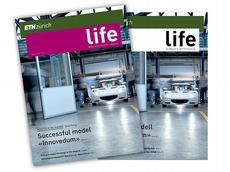New magazine for the ETH community
The new ETH internal magazine puts employees in central focus: "life - ETH community magazine" will be published for the first time this autumn, conveying the strategy, values and qualities of ETH Zurich’s working community.

With the release of a staff magazine and a
future intranet, Internal Communications at ETH puts on a new face.
"life", a magazine created from scratch for the ETH community will be
published starting in October 2013. Aimed at the ETH workforce, be it employees in teaching,
research or administration, the magazine will convey the strategy, values and
qualities of ETH Zurich and inform the
ETH community about how their university is developing as well as depict working
environments and campus life.
Through attractive articles and images, "life" puts the people who work at ETH into the foreground as it explores internal topics like how the university management strategy connects to the daily life of the ETH workforce. The overall aim of the publication is to create a sense of community and encourage interaction and networking within ETH. The layout has also been aligned with ETH Zurich's corporate design and was conceptualised by the Paroli AG agency in Zurich.
Due to the growing proportion of international colleagues, Corporate Communications is launching "life" in both German and English. "The English version of "life" is a small, but important building block towards building bridges to strengthen the relationship between the international ETH community and the Swiss environment of ETH Zurich," explains Norbert Staub, Head Internal Communications for ETH Zurich.
A standalone magazine
As part of the ETH web relaunch, Corporate Communications is also working on the introduction of the ETH intranet, which together with "life" will form a solid platform for future internal communication. "life" will take the role of delving deeper into the strategies, organising facts and portraying the people who help to develop ETH Zurich in their daily routines.
"ETH's successes and achievements are down to people from all areas of work, so as part of "life", we want to report informatively about researchers and staff in technological, administrative roles to help develop a sense of community at ETH," says Norbert Staub. Members of the ETH community will conveniently receive "life" magazine directly at their doorsteps.
Another difference between "life" and "ETH Life Print" is that it will be published four times rather than nine times per year. "life" differentiates itself from the student magazine "Polykum" through its focus on employee and organisational topics, publication frequency and the fact that it will be produced in two different languages. "However, the student perspective on campus life is still an important asset for ETH Zurich, and we will continue to represent it in our various communication channels," says Norbert Staub.
To support the sharing and forming of opinions, "life" will also provide a forum where the Executive Board and university organisations (University Assembly HV, Conference of the faculty KdL, Academic Association of Scientific Staff at the ETH Zurich AVETH, the VSETH Student Association and the Personnel Committee PeKo) can share their concerns and positions.
New delivery methods
Delivery of the two publications will also change. Students will receive "Polykum"; the ETH staff will receive "life". Doctoral students and tutorial assistants will automatically receive both publications. ETH researchers and staff can receive "Polykum" at their workplace or as a PDF if they wish, and students can subscribe to a PDF version of "life". The corresponding subscription options can be found on the ETH Address Application www.adressen.ethz.ch.







READER COMMENTS